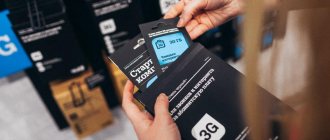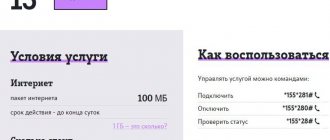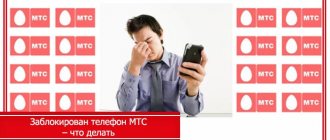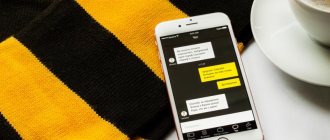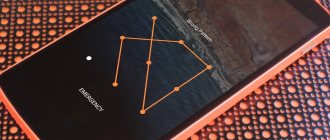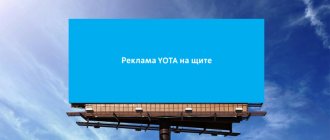To carry out wireless mobile telephony and data transmission, cellular operators use radio frequencies that range from 250 MHz to 3 GHz. Considering that these channels are also used for other communications, cell phone manufacturers were allocated four GSM bands: 850/900/1800/1900 MHz. There are two relevant bands in Russia: 900 and 1800.
The first allows you to cover large service areas, and the second adapts service to small areas with a high subscriber density. The phones themselves can have two, three or four bands - this is quite relevant when traveling around the world. Tele2 gsm, by agreement with other cellular operators, uses only the 1800 MHz range, the shortcomings of which are compensated by the construction of more towers for signal transmission. To date, no agreement on the gsm standard has been reached in Moscow.
In this regard, in the capital Tele2 is available only to subscribers whose telecommunication devices support new generation networks: 3G and 4G.
GSM standard
Modern devices are able to support 4 different gsm standards:
- 850 MHz;
- 900;
- 1800;
- 1900.
In Russia, telephone companies use only two options - 900 and 1800, while most of the Internet frequencies were chosen by operators in the distant past, when Tele2 did not yet exist. This has led to some difficulties for the said provider in the present, since most of the provided options have been taken over by competitors.
It is worth emphasizing that the use of two standards out of four in Russia does not mean that subscribers should ignore the remaining ones. The most preferable models are smartphones and equipment that can support all kinds of bands. This will allow equipment owners not to worry about difficulties with communication abroad, in regions with other requirements.
How to check mobile connectivity
Do you want to know if your smartphone supports fourth generation communications? There are several ways.
Instructions
Each device is accompanied by a document indicating the characteristics. There you can find a 4G or LTE entry, which means that the device supports this type of connection.
Store consultant
When buying a new phone, ask the seller if this model supports the new type of connection.
Type your device model into the search bar of your browser and find its characteristics. Among them will be indicated what types of communication it supports.
It is worth noting that at the moment even budget models support LTE.
At what frequency does 3g and 4g Tele2 operate?
When studying the question of what frequency Tele2 operates at, we have to return to the idea that most of the operating ranges were occupied at the beginning of the millennium. The current situation has led to:
- Tele2 had to use the remaining options;
- in different areas of the country, the mobile company offers users different frequencies;
- in the Moscow region there are no free standards left for working in the 3g network, and therefore users here are offered exclusively 4g connections.
But, if we focus exclusively on numbers, then subscribers should focus on 1710, 1725, 1778, 1784, 1805, 1820, 1873 and 1879 MHz. The listed parameters are available in all constituent entities of Russia, except the capital and region.
Optimal Tele2 tariffs for 4G
Now consider the most favorable tariffs from Tele2 for using a new type of communication.
Internet for devices
This is the main and only tariff suitable for this purpose. A month of use is 299 rubles for 7 gigabytes. A minute of call will cost 1.80 rubles. SMS to numbers of Russian operators – 2.50 rubles per minute. The tariff can be used if the device supports this type of communication. There is no fixed subscription fee, but 3 rubles will be charged daily. The tariff is great for all types of devices.
To connect, you can purchase a SIM card online and pick it up at your nearest office. Or order it at the operator's office.
Internet Suitcase
This package provides a lot of traffic - 30 Gigabytes. More precisely, this is a separate service, it can be connected to any package. To connect you need a SIM card and a router. 30 days of use - 899 rubles.
- By visiting your personal account;
- By entering the special code *155*211#
- To check the status *155*021#
- To deactivate *155*210#
Does Tele2 support frequency aggregation?
When it comes to frequency aggregation, experts understand this concept as combining several standards to increase the speed and quality of data transmission. But improving quality requires the service company to have the appropriate capabilities and equipment.
The modern LTE (4g) Tele2 network allows you to improve the quality of the signal from radio towers. That is, aggregation is possible. But it should be taken into account that it requires a 4g connection in the region, and such a coverage area is not yet available in all regions of Russia. Therefore, detailed and accurate information should be obtained from the contact center employees, who will advise calling customers on any questions that arise.
What is 4G from Tele2
This is a new generation type of communication. It is better quality, more accessible, faster and more comfortable than mobile Internet.
Difference from 3G
3G combines high-speed Internet access and radio communications. It first appeared in Russia in 2002. Maximum data transfer rate:
- If the device is not moving – 2048 Kbps.
- If the speed of the device is up to 3 km/h – 348 Kbps.
- If the device is moving at a speed of more than 120 km/h – 144 Kbps.
Regarding 4G, it is capable of providing high speed Internet access and significantly improved voice quality. Networks of this generation began to appear in 2010. The speed is much higher:
- For mobile devices – 100 Mbit/s
- For stationary - 1 Gbit/s.
The new type of communication is based on packet data transmission and a special technology that ensures the transmission of voice signals over the Internet - Voiceover IP.
List of frequencies on which it operates in the Russian Federation:
- b3 (1805-1880MHz);
- b7 (2620-2690MHz);
- b20 (791-821MHz);
- b31(frequency 450MHz);
- b38 (2570-2620 MHz).
Checking frequency via USB modem
It is worth emphasizing that those users who want to check the Tele2 4g frequency via a modem should use the device interface. The exact procedure depends on the model of the device you choose, but in general it will require the following steps:
- First of all, you need to open the settings section;
- here you should select the tab that mentions diagnostics or signal information;
- after which all that remains is to find the RSSI item or the signal level at which the network should operate.
In addition, there are special utilities that help make measurements, but given the presence of the necessary functionality in the modem itself, their use is not necessary.
Testing frequency on iPhone
Owners of Apple equipment can perform the operation much easier. Software facilitates this. Determination order:
- Disable Wi-Fi support on your mobile device.
- In the dialing window, write the combination - * 3001 # 12345 # *, then call.
- The Field Test menu will appear in front of you.
- Open the “Serving Cell info” tab.
- The currently set frequency value will appear on the screen.
In addition to the range being used, the user will see other bands. They are automatically set depending on the signal level. Whoever has the highest priority is the one who gets connected.
Tele2 frequencies in Moscow
7 MHz on carrier 6200) Band3 - 5 MHz Skylink (Tele2)
: Band31 - 4.4 MHz (3 MHz used)
7)/ CA_1_7 /5+10/ CA_1_20 /5+5/ CA_1_7_20 /5+10+5/
Distribution of GSM900/1800 frequency bands between operators by regions of the Russian Federation (as of December 24, 2018)
Distribution of GSM900/1800 frequency bands between operators by regions of the Russian Federation (according to CNews) Distribution of GSM900 frequency bands between operators by regions of the Russian Federation (as of 07/01/2016):
gsm900.pdf (70.38 KB) Distribution of GSM1800 frequency bands between operators by regions of the Russian Federation (as of 07/01/2016): gsm1800.pdf (58.91 KB) Distribution of GSM channels (relevance questionable)
Thanks ash16
and
vladaha
for providing sources.
Thanks Mikl1984
.
Attention!
Feel free to share relevant information on this topic. If this information is quite voluminous (for example, complete information on frequencies in a certain region), please create a separate post, a link to which will be added to the header. For questions about filling out the header, please contact the Curator.
Post edited by vvireless
— 10.03.20, 06:56
Yota and Megafon combined their frequencies into B7
LTE details by operator
Fly (Tattelecom)
B3 1800
- 10 MHz Carrier
1876 B38 TDD 2600
- 20 MHz Carrier
37900
MTS
B1 2100
- 5 MHz Carrier
425
/support 256QAM/
B3 1800
- 10 MHz Carrier
1726
/support 256QAM/ 1 5 MHz Carrier
1725
/support 256QAM/
B7 2600
- 10 MHz Carrier
3200
/ support 256QAM /
B38 TDD 2600
- 20 MHz Carrier
38100
/ support 256QAM /
Aggregation CA_3_7
CA_7_3
10+5 MHz 5+10 MHz 10+10 MHz Press release
CA_3_38
— 10+20
CA_3_7_38
10+10+20 MHz
Beeline
B3 1800
- 5-10 MHz Carrier
1299
/ support 256QAM /
B7 2600
- 10 MHz Carrier
3300
/ support 256QAM /
Aggregation CA_3_7
CA_7_3
5+10 MHz 10+5 MHz 10+10 MHz
B20 800
5 MHz Carrier
6175
/ support 256QAM/
B3 1800
10 MHz Carrier
1575
/ support 256QAM/
B7 2600
10 MHz Carrier
3400
/ support 256QAM/ Aggregation
CA_3_7 CA_7_3
10+10 MHz
If you have anything to add, write to qms and I will correct it.
Post edited by ash16
— 12.09.19, 08:47
Latest changes: May 22, 2021: T2's LTE B3 band has been expanded to 15 MHz. According to LO, T2 has B20, and aggregation with this range.
MTS V38 in St. Petersburg
DL/UL configuration #1, Special subframe configuration #7.
Which means that with a 20 MHz bandwidth, QAM64 “up”, TDD Config=1, and SSF config =7, MIMO 2x2, the
theoretical limit: with a device with
QAM64
“down”, the limits will be:
DL 82 Mbit/s and UL 32 Mbit/s
(in practical tests I saw 60 Mbit/s myself).
with a device with QAM256
“down”, limits:
DL 109 Mbit/s and UL 32 Mbit/s
(in practical tests
Thanatos MD
saw 82 Mbit/s).
There is no information about the use of EGSM. On 12/21/18 information appeared about a piece of EGSM 1.7 MHz from MTS.
UMTS: B1(2100) 5. MHz (EARFCN 10687, UL 1947.4 MHz, DL 2137.4 MHz) B8(900) 5 MHz (EARFCN 3076, UL 910.2 MHz, DL 955.2 MHz)
LTE: B3(1800) 10MHz (EARFCN 1596, UL 1749.6MHz, 1844.6MHz) MIMO 1×1 (SISO) B7(2700) 20MHz+20MHz (EARFCN 2850, EARFCN 3048) MIMO 1×1 (SISO)
Post edited by andrew.woronkov
— 05/22/19, 09:19
ash16,
Yes, it’s not officially there yet, but it’s launched on some BSs.
While the topic is still “in its infancy”, I suggest:
1. Use industry standard designations to designate CA combinations, such as CA_3_7 or CA_7_7_3. I think, however, that “very canonical, from the standard” designations like CA_3A_7A or CA_7C_3A should not be used due to their non-obvious (to the untrained eye) association with the number of aggregated carriers. That is, if by the designation “CA_7_7_3” it is immediately clear that this is a 3CA combination, then by “CA_7C_3A” it is not immediately clear.
2. Consider logically “symmetrical” combinations separately. For example, CA_3_7 and CA_7_3, CA_7_3_7 and CA_7_7_3. Theoretical “symmetry” does not mean equivalence in a real network.
3. When mentioning intra-band aggregation, always clarify whether we are talking about aggregation of contiguous or non-contiguous bands. Or, as an option, indicate the specific channels (EARFCN) of the carriers used - then the “adjacency/non-adjacency” can be easily calculated. For example, Megafon in Moscow uses adjacent carriers on channels 2850 and 3048 in B7.
4. Distinguish between cases when aggregated components can only be received from the same BS, and when their source can be (or should be) different stations. That is, to distinguish inter-site CA from “regular”, intra-site.
5. Specify the maximum efficient modulation scheme supported for each carrier (in each band). For today, there will be enough information regarding the downlink. Actually, for the vast majority of networks currently operating it will be 64QAM or 256QAM.
Post edited by vvevvevve
— 28.04.17, 22:34
As I wrote, the netmonitor in my Samsung does not show this.
Post edited by yanixxx
— 29.04.17, 00:34
Personally, I first saw B3 20 MHz at MTS back in September 2015, when Kotelniki opened. First, only at this station itself, and after a couple of months, at the two neighboring ones, Zhulebino and Lermontovsky Prospekt. Links: 20 MHz in Kotelniki 20 MHz in Zhulebino
Post edited by yanixxx
— 28.04.17, 23:53
sandwern,
Exactly. But priority goes to B7, which is very common in mega.
PS.
It seems that in some (very small) regions, mega gives iota access to B20, but only because there is no other option. yanixxx,
I wouldn’t be surprised that in 250-02. When I was on the iota, my devices (windowphones) unsuccessfully tried to connect to LTE 250-02, if 250-11 is missing. A lot of time (like, more than six months) after I left them, they still reported to the media that they had fixed the problems that arose because of this, but I never went back to them. So I didn't check it like now.
Subscriber questions
Is it possible to connect 4G to Tele2 Kazakhstan?
Yes, by visiting the website internet.tele2.kz or calling the free short number 800.
Does using 4G affect traffic consumption?
Yes, and many users noticed this. This is because the speed has become higher and, accordingly, traffic is wasted faster. For an analogy, you can imagine a water tap; if you open it further, more water will be consumed, and here too.
Corporate Internet
Corporate Internet is a regular Internet for business in the form of special tariff plans. General tariffs allow customers of the Tele2 operator to independently choose the appropriate volume of communication options, SMS messages and mobile Internet for the entire company or other legal entity. It is also possible to distribute services among all employees. There is also a limitation. The total number of subscribers from this legal entity should not exceed 150 people.
The constructor on the official website includes the following features:
- 7,500, 15,000 and 30,000 minutes nationwide.
- 225, 375 and 525 gigabytes of Internet traffic for everyone.
- 150, 450 and 750 SMS messages.
Important! Based on this, the total amount of the subscription fee is obtained, which varies from 4,000 to 10,000 rubles per month for a full set of all options. The advantage of this approach is that all balances are carried over to the next month, and calls within the network are not charged.
Moreover, each tariff participant is connected to the additional “Team Player” offer. If a person completely exhausts his limit, then further charging occurs as follows:
- Calls to any local number cost 1 ruble per minute.
- Calls to Tele2 numbers throughout Russia cost 1 ruble per minute.
- Calls to numbers of other operators throughout Russia - 5 rubles per minute.
- Long-distance calls – 3 rubles per minute.
- Network access – 6.5 rubles per megabyte.
- SMS messages within your home region – 1.5 rubles per message.
- SMS messages throughout Russia – 2.5 rubles per message.
How to find out if the Internet is connected to Tele2 on your phone
Internet is a paid service, so it may be displayed with other additional options. To check paid subscriptions and services, you can use the USSD combination *153#. In response, you will receive an SMS message with a list of all free and paid options and their costs.
Important! You can complete the request completely free of charge, not only in your home region, but also in any other region, and even in roaming with a negative balance.
Similar actions are carried out through the official website, where the personal self-service account is located, as well as its mobile analogue - the My Tele2 application. Both of them require you to go through a simple registration or log in with your credentials. In them you can not only find out about all the promotions, discounts and innovations, but also find out what services are connected to the main tariff and how much of them is available.
If everything described above does not produce results, or a person is unable to register or log in (send a USSD request), then you should call the Customer Support Center at 0611 or 8 800 555 0611. In extreme cases, you can do it yourself contact the nearest Tele2 cellular communication center or salon.
Important! If you want to understand whether the Internet is physically connected on your smartphone, then you just need to try to go to some website or your page on a social network. You can also find out the Internet status from the “Mobile data transfer” icon, located in the quick access menu on any phone.
LTE frequency bands in Russia
Below is a table with a list of frequency bands allocated in Russia for LTE
(full list of LTE frequencies defined by 3GPP). A figure is also presented after the table.
Phones with 4G
| № | Operator | Frequency range (UL/DL), MHz | Channel width, MHz | Duplex type | 3GPP number |
| 1 | Yota (Megafon) | 2500-2530 / 2620-2650 | 30 | FDD | Band 7 |
| 2 | Megaphone | 2530-2540 / 2650-2660 | 10 | FDD | Band 7 |
| 3* | Megaphone | 2575-2595 | 20 | TDD | Band 38 |
| 4 | MTS | 2540-2550 / 2660-2670 | 10 | FDD | Band 7 |
| 5* | MTS | 2595-2615 | 20 | TDD | Band 38 |
| 6 | Beeline | 2550-2560 / 2670-2680 | 10 | FDD | Band 7 |
| 7 | Rostelecom/Tele2 | 2560-2570 / 2680-2690 | 10 | FDD | Band 7 |
| 8** | Rostelecom/Tele2 | 832-839.5 / 791-798.5 | 7.5 | FDD | Band 20 |
| 9** | MTS | 839.5-847 / 798.5-806 | 7.5 | FDD | Band 20 |
| 10** | Megaphone | 847-854.5 / 806-813.5 | 7.5 | FDD | Band 20 |
| 11** | Beeline | 854.5-862 / 813.5-821 | 7.5 | FDD | Band 20 |
| 12*** | MTS | 2595-2620 | 25 | TDD | Band 38 |
| 13 | Tele 2 | 453-457.4 / 463-467.4 | 4.4 | FDD | Band 31 |
* — frequencies are allocated only for use in Moscow and the Moscow region. ** — the allocated channel width (7.5 MHz) does not correspond to the standard. You can use 5 MHz of them, for example, or you can negotiate with a “neighboring” operator and, by combining the two ranges, get a completely standard channel width of 15 MHz. And then use it using RAN Sharing technology. *** - with the exception of the territory of Moscow, the Moscow region, the Republic of Crimea and the city of Sevastopol.
Below are pictures with the distribution of frequencies between operators. List of launched LTE networks in Russia. Phones with 4G
Phones with 4G
On October 6, 2015, an auction of frequencies in the 1800 MHz range took place. Information about the lots is in the table below.
| № | Operator | Region | Frequency range (UL/DL), MHz | Channel width, MHz | Duplex type | 3GPP number | Final price of the lot, million rubles. |
| 1 | Megaphone | Rep. Dagestan | 1740-1755 / 1835-1850 | 15 | FDD | Band 3 | 1060,164 |
| 2 | Megaphone | Karachay-Cherkess Republic | 1755-1768,8 / 1850-1863,8 | 13,8 | FDD | Band 3 | 200.344 |
| 3 | MTS | Rep. North Ossetia Alania | 1748,2-1755 / 1843,2-1850 1764,6-1769,8 / 1859,6-1864,8 | 6.8 and 5.2 | FDD | Band 3 | 275,890 |
| 4 | VimpelCom (Beeline) | Stavropol region | 1710,1-1723,8 / 1805,1-1818,8 | 13,7 | FDD | Band 3 | 1701,327 |
| 5 | MTS | Orenburg region | 1725-1727,8 / 1820-1822,8 1748,4-1755 / 1843,4-1850 | 2.8 and 6.6 | FDD | Band 3 | 587,627 |
| 6 | MTS | Perm region (except Komi-Permyak district) | 1727-1735 / 1822-1830 1750-1751,8 / 1845-1846,8 1769-1770 / 1864-1865 | 8, 1.8 and 1 | FDD | Band 3 | 744,604 |
| 7 | Tele 2 | Samara region | 1762,4-1770 / 1857,4-1865 | 7,6 | FDD | Band 3 | 1082,840 |
| 8 | MTS | Komi-Permyak district of Perm region | 1769-1770 / 1864-1865 | 1 | FDD | Band 3 | 0,545 |
| 9 | VimpelCom (Beeline) | Rep. Buryatia | 1755-1768,6 / 1850-1863,6 1769,6-1770 / 1864,6-1865 | 13.6 and 0.4 | FDD | Band 3 | 326,094 |
| 10 | MTS | Amur region | 1725-1729,6 / 1820-1824,6 1746,4-1755 / 1841,4-1850 | 4.6 and 8.6 | FDD | Band 3 | 303,349 |
Phones with 4G
Tattelecom also has frequencies in the 1800 MHz range (Band 3) in Tatarstan.
In addition to the frequencies shown in the table, operators have other frequencies in the 1800 MHz range. For example, the ones they used/are using for GSM (2G). There are already a number of regions in Russia where LTE networks have been launched in the 1800 MHz range (band 3).
On February 11, 2021, an auction of band 38 frequencies took place. The results of the auction are given below. Lots in the Jewish Autonomous Region and the Magadan Region remained unplayed.
| № | Operator | Region | Frequency range (UL/DL), MHz | Channel width, MHz | Duplex type | 3GPP number | Final price of the lot, million rubles. |
| 1 | Beeline | Altai region | 2570 — 2595 | 25 | TDD | Band 38 | ? |
| 2 | Megaphone | Amur region | 2570 — 2595 | 25 | TDD | Band 38 | ? |
| 3 | Beeline | Arhangelsk region | 2570 — 2595 | 25 | TDD | Band 38 | ? |
| 4 | Beeline | Astrakhan region | 2570 — 2595 | 25 | TDD | Band 38 | ? |
| 5 | Megaphone | Belgorod region | 2570 — 2595 | 25 | TDD | Band 38 | ? |
| 6 | Beeline | Bryansk region | 2570 — 2595 | 25 | TDD | Band 38 | ? |
| 7 | Megaphone | Vladimir region | 2570 — 2595 | 25 | TDD | Band 38 | ? |
| 8 | Beeline | Volgograd region | 2570 — 2595 | 25 | TDD | Band 38 | ? |
| 9 | Megaphone | Vologda Region | 2570 — 2595 | 25 | TDD | Band 38 | ? |
| 10 | Beeline | Voronezh region | 2570 — 2595 | 25 | TDD | Band 38 | ? |
| 11 | Megaphone | Saint Petersburg | 2570 — 2595 | 25 | TDD | Band 38 | ? |
| 12 | Megaphone | Transbaikal region | 2570 — 2595 | 25 | TDD | Band 38 | ? |
| 13 | Megaphone | Ivanovo region | 2570 — 2595 | 25 | TDD | Band 38 | ? |
| 14 | Megaphone | Irkutsk region | 2570 — 2595 | 25 | TDD | Band 38 | ? |
| 15 | Beeline | Kabardino-Balkarian Republic | 2570 — 2595 | 25 | TDD | Band 38 | ? |
| 16 | Beeline | Kaliningrad region | 2570 — 2595 | 25 | TDD | Band 38 | ? |
| 17 | Beeline | Kaluga region | 2570 — 2595 | 25 | TDD | Band 38 | ? |
| 18 | Megaphone | Kamchatka Krai | 2570 — 2595 | 25 | TDD | Band 38 | ? |
| 19 | Beeline | Karachay-Cherkess Republic | 2570 — 2595 | 25 | TDD | Band 38 | ? |
| 20 | Beeline | Kemerovo region | 2570 — 2595 | 25 | TDD | Band 38 | ? |
| 21 | Megaphone | Kirov region | 2570 — 2595 | 25 | TDD | Band 38 | ? |
| 22 | Beeline | Kostroma region | 2570 — 2595 | 25 | TDD | Band 38 | ? |
| 23 | Beeline | Krasnodar region | 2570 — 2595 | 25 | TDD | Band 38 | ? |
| 24 | Megaphone | Krasnoyarsk region | 2570 — 2595 | 25 | TDD | Band 38 | ? |
| 25 | Motive | Kurgan region | 2570 — 2595 | 25 | TDD | Band 38 | ? |
| 26 | Beeline | Kursk region | 2570 — 2595 | 25 | TDD | Band 38 | ? |
| 27 | Megaphone | Leningrad region | 2570 — 2595 | 25 | TDD | Band 38 | ? |
| 28 | Beeline | Lipetsk region | 2570 — 2595 | 25 | TDD | Band 38 | ? |
| 29 | Megaphone | Murmansk region | 2570 — 2595 | 25 | TDD | Band 38 | ? |
| 30 | Megaphone | Nenets Autonomous Okrug | 2570 — 2595 | 25 | TDD | Band 38 | ? |
| 31 | Megaphone | Nizhny Novgorod Region | 2570 — 2595 | 25 | TDD | Band 38 | ? |
| 32 | Megaphone | Novgorod region | 2570 — 2595 | 25 | TDD | Band 38 | ? |
| 33 | Megaphone | Novosibirsk region | 2570 — 2595 | 25 | TDD | Band 38 | ? |
| 34 | Beeline | Omsk region | 2570 — 2595 | 25 | TDD | Band 38 | ? |
| 35 | Megaphone | Orenburg region | 2570 — 2595 | 25 | TDD | Band 38 | ? |
| 36 | Megaphone | Oryol Region | 2570 — 2595 | 25 | TDD | Band 38 | ? |
| 37 | Megaphone | Penza region | 2570 — 2595 | 25 | TDD | Band 38 | ? |
| 38 | Beeline | Perm region | 2570 — 2595 | 25 | TDD | Band 38 | ? |
| 39 | Beeline | Primorsky Krai | 2570 — 2595 | 25 | TDD | Band 38 | ? |
| 40 | Beeline | Pskov region | 2570 — 2595 | 25 | TDD | Band 38 | ? |
| 41 | Beeline | Republic of Adygea | 2570 — 2595 | 25 | TDD | Band 38 | ? |
| 42 | Beeline | Altai Republic | 2570 — 2595 | 25 | TDD | Band 38 | ? |
| 43 | Beeline | Republic of Bashkortostan | 2570 — 2595 | 25 | TDD | Band 38 | ? |
| 44 | Megaphone | The Republic of Buryatia | 2570 — 2595 | 25 | TDD | Band 38 | ? |
| 45 | Beeline | The Republic of Dagestan | 2570 — 2595 | 25 | TDD | Band 38 | ? |
| 46 | Megaphone | The Republic of Ingushetia | 2570 — 2595 | 25 | TDD | Band 38 | ? |
| 47 | Beeline | Republic of Kalmykia | 2570 — 2595 | 25 | TDD | Band 38 | ? |
| 48 | Megaphone | Republic of Karelia | 2570 — 2595 | 25 | TDD | Band 38 | ? |
| 49 | Megaphone | Komi Republic | 2570 — 2595 | 25 | TDD | Band 38 | ? |
| 50 | Megaphone | Mari El Republic | 2570 — 2595 | 25 | TDD | Band 38 | ? |
| 51 | Megaphone | The Republic of Mordovia | 2570 — 2595 | 25 | TDD | Band 38 | ? |
| 52 | Megaphone | The Republic of Sakha (Yakutia) | 2570 — 2595 | 25 | TDD | Band 38 | ? |
| 53 | Megaphone | Republic of North Ossetia-Alania | 2570 — 2595 | 25 | TDD | Band 38 | ? |
| 54 | Tattelecom | Republic of Tatarstan | 2570 — 2595 | 25 | TDD | Band 38 | ? |
| 55 | Megaphone | Tyva Republic | 2570 — 2595 | 25 | TDD | Band 38 | ? |
| 56 | Megaphone | The Republic of Khakassia | 2570 — 2595 | 25 | TDD | Band 38 | ? |
| 57 | Megaphone | Rostov region | 2570 — 2595 | 25 | TDD | Band 38 | ? |
| 58 | Megaphone | Ryazan Oblast | 2570 — 2595 | 25 | TDD | Band 38 | ? |
| 59 | Beeline | Samara Region | 2570 — 2595 | 25 | TDD | Band 38 | ? |
| 60 | Megaphone | Saratov region | 2570 — 2595 | 25 | TDD | Band 38 | ? |
| 61 | Megaphone | Sakhalin region | 2570 — 2595 | 25 | TDD | Band 38 | ? |
| 62 | Motive | Sverdlovsk region | 2570 — 2595 | 25 | TDD | Band 38 | ? |
| 63 | Beeline | Smolensk region | 2570 — 2595 | 25 | TDD | Band 38 | ? |
| 64 | Beeline | Stavropol region | 2570 — 2595 | 25 | TDD | Band 38 | ? |
| 65 | Megaphone | Tambov Region | 2570 — 2595 | 25 | TDD | Band 38 | ? |
| 66 | Megaphone | Tver region | 2570 — 2595 | 25 | TDD | Band 38 | ? |
| 67 | Beeline | Tomsk region | 2570 — 2595 | 25 | TDD | Band 38 | ? |
| 68 | Beeline | Tula region | 2570 — 2595 | 25 | TDD | Band 38 | ? |
| 69 | Motive | Tyumen region | 2570 — 2595 | 25 | TDD | Band 38 | ? |
| 70 | Megaphone | Udmurt republic | 2570 — 2595 | 25 | TDD | Band 38 | ? |
| 71 | Megaphone | Ulyanovsk region | 2570 — 2595 | 25 | TDD | Band 38 | ? |
| 72 | Megaphone | Khabarovsk region | 2570 — 2595 | 25 | TDD | Band 38 | ? |
| 73 | Motive | Khanty-Mansi Autonomous Okrug-Yugra | 2570 — 2595 | 25 | TDD | Band 38 | ? |
| 74 | Beeline | Chelyabinsk region | 2570 — 2595 | 25 | TDD | Band 38 | ? |
| 75 | Vainakh Telecom | Chechen Republic | 2570 — 2595 | 25 | TDD | Band 38 | ? |
| 76 | Beeline | Chuvash Republic (Chuvashia) | 2570 — 2595 | 25 | TDD | Band 38 | ? |
| 77 | Megaphone | Chukotka Autonomous Okrug | 2570 — 2595 | 25 | TDD | Band 38 | ? |
| 78 | Motive | Yamalo-Nenets Autonomous Okrug | 2570 — 2595 | 25 | TDD | Band 38 | ? |
| 79 | Beeline | Yaroslavl region | 2570 — 2595 | 25 | TDD | Band 38 | ? |
Phones with 4G
If you did not find the information you are interested in on LTE/LTE-A in this article, write me an email about it at [email protected] I will try to add it as soon as possible.
All about Tele2 4G (LTE)
Fourth generation cellular networks providing high-speed Internet access are deployed by all Russian operators. Some have a slightly worse coverage area, some have a little better, and some are represented in a limited number of regions - there are many differences. The discount operator Tele2 also has fourth-generation base stations. Today 4G from Tele2 is available in many regions, including small towns. Let's talk about this in more detail.
Options
According to international standards, Internet speeds using 4G technology should be from 1 Gb/s for a user moving at a speed of less than 10 km/h, and from 100 Mb/s for a subscriber moving at a speed of up to 120 km/h. Unfortunately, these indicators are still more realistic to achieve in the laboratory than in practice.
In Russia, Tele2 uses channels B31, 20, 7 for LTE data transmission, most of which received licenses after the merger with Rostelecom. 5G is currently being actively developed , which is planned to be put into operation by 2021 . So, it is quite possible that in the near future the question “what is LTE on iPhone?” will lose its relevance.
Technology and coverage area
LTE from Tele2 allows you to experience all the delights of high-speed mobile Internet - fast downloading files, watching videos in good quality, low ping and affordable tariffs. The wide coverage of fourth generation networks allows you to count on high-quality communications in many localities in Russia. Their work is carried out in the following frequency ranges - Band 7, Band 20 and Band 31 .
To work in 4G networks from Tele2, you can use any equipment - smartphones, tablet PCs, modems and routers. The main thing is that the equipment can operate in the above frequency ranges. If this is not the case, then she simply will not be able to register with the desired network. This often happens with equipment that was designed to operate in other countries using different frequency bands.
But there is no need to be afraid of buying equipment - all devices officially imported into Russia will be able to work in any domestic fourth-generation networks, including 4G from Tele2. The main thing is to buy them in official stores, and not through Chinese or any other online stores.
Let's see what we can use in 4G networks from Tele2:
- Any smartphones and tablets officially imported into Russia;
- Modems from Tele2 and universal modems with support for the required bands;
- Any mobile and stationary routers with 4G.
Thus, the range of equipment is not limited in any way, which is already a big plus.
Branded equipment includes Tele2 4G modems, sold complete with a SIM card. They can provide data reception speeds of up to 100 Mbit/s and upload speeds of up to 50 Mbit/s. In fact, the actual speed will be lower, which is due to the congestion of base stations and a large number of subscribers.
Remember that all the maximum indicators in the technical characteristics were identified in laboratory conditions - in practice they are much worse.
In addition to the modem, Tele2 offers compact mobile routers for working in 4G networks. Being equipped with batteries, they can operate autonomously. A SIM card is included in the package. You can connect up to 10 devices to this router - tablets, smartphones, SMART TVs and much more. The capacity of the built-in battery is 2000 mAh, which ensures autonomous operation for 5-6 hours (depending on the load).
4G coverage from Tele2 is present only in populated areas - you can check the coverage area on the operator’s official website, or directly on our website.
Here you will see a constructed map for second, third and fourth generation networks - for greater convenience they are marked in different colors. The widest coverage is with second generation networks. They are followed by 3G networks and areas with 4G network coverage.
The 4G coverage area map from Tele2 was generated by computer modeling and does not take into account the peculiarities of radio wave propagation and other factors affecting signal strength and Internet speed at a particular point.
What tariff options can you choose to surf the Internet from a mobile phone?
Today there are two excellent offers from TELE2 that work to provide the service of accessing the Internet from your mobile phone. Below we will talk about:
- Unlimited Opera Mini
- Internet from your phone
These two services are an excellent opportunity to realize your capabilities on the Internet, so any interested visitor needs to know how to activate them on their mobile phone.
- Unlimited Opera Mini is activated by first receiving the Internet browser file on your mobile phone. This can be done by downloading from a mobile phone or via a personal computer. The link of the form “https://spb.tele2.ru/internet/bezlimitnaya-opera-mini/” indicates the exact names of the necessary parameters for obtaining data. The required option can be activated by contacting the “Personal Account” or via a USSD request in the established format “*155*11#” + “Call”. In addition, you can activate the service by contacting the office: how to do this is written above. It is expected to disable the system at a price of 0 rubles by contacting the “Personal Account” or by dialing the USSD format “*155*10#” + “Call”. The price of work per day is 2.9 rubles.
- Internet from a phone requires a payment of 4.5 rubles per day for use, while this service can be activated by working with the “Personal Account” or through a USSD code of the form “*155*31#” + “Call”. Disabling is carried out at a price of 0 rubles by working with the already familiar “Personal Account” or by typing the key combination “*155*30#” + “Call”.
IMPORTANT: The second and first (and subsequent) activations of the option cost 10 rubles. Subscription fee – 4.5 rubles. Disconnection – 0 rubles.


